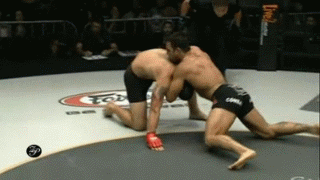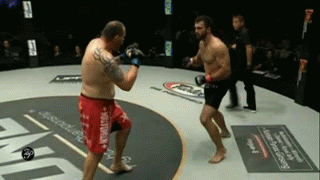
(“No, God Damn it, we’re on the Y part of the song, not the A! Have you guys even heard The Village People before?!”
We’re only three weeks into the NFL regular season, yet fans all over the country have become infuriated with the league over the blown calls and inconsistency of the replacement referees who have been officiating games during the referee lockout. The fact that last night’s Seahawks vs. Packers game was literally decided by the poor interpretation of the league’s simultaneous catch rule has been the focus of water cooler discussions all over the country – even here. Yet this inconsistency is hardly unique to the replacement referees, or even professional football. As MMA fans, we see this all the time.
Case in point: During the main event of Saturday’s UFC 152, Vitor Belfort threw a kick at the head of a “downed” Jon Jones. Despite this being against the rules, ”Big” John McCarthy simply said to Jon Jones “You wanted to play the game.” Is this selective enforcement of the rules good for our sport? Today George Shunick and Seth Falvo will make the arguments for and against this practice.
The Argument For, by George Shunick:
Let’s get this out of the way; the phrase “you’re playing the game” stems from a fundamental dissonance in the Unified Rules of professional Mixed Martial Arts. Namely, that stomps, soccer kicks and knees to the head of a downed opponent are maneuvers that should be allowed in accordance with the philosophy of the sport, but can’t due to certain political realities and, arguably, health and safety concerns. So certain situations arise, like Vitor Belfort throwing a head kick at a crouching Jon Jones, which defy the rules, but not the spirit of them.
Even though it has its detriments, it’s because of this that “you’re playing the game” is an acceptable resolution to this dissonance. Its main problem is that there is a certain gray area that stems from it. Let’s concede that a legitimately wounded fighter, or a fighter who has been forced to an inferior position by his opponent, cannot be kneed in the head, stomped on or soccer kicked. That is, certainly, the intended effect of the rules as they are. However, certain fighters seek to exploit those loopholes in a manner that is arguably antithetical to the ideals of the sport – by removing an aspect of their opponent’s arsenal not through their own abilities, but by the manipulation of regulatory measures. Despite Rich Franklin’s advice, there just is something fundamentally wrong if the perfect defense in a combat sport for a head kick is actually making you more susceptible to them.
But where is the line? That’s a little more difficult to ascertain. However, there are incidents that unquestionably merit a stern “you’re playing the game.” One that springs to mind is Paul Buentello putting his hand on the mat while getting kneed by Cheick Kongo. Kongo had Buentello in a front headlock and began kneeing him in the head. Buentello, understandably less than thrilled about his situation, put his hand on the ground, legally declaring himself down and rendering any knees thrown to his head illegal. Kongo became enraged by this gesture and attempted to throw knees to Buentello’s groin, as Cheick Kongo is wont to do in these situations. He missed however, and hit Buentello three more times in the head. Herb Dean stopped the fight, but only to warn Buentello about “playing the game.”
It was the right call; Buentello positioning had barely changed. If anything, he consciously made a decision to impede his own ability to defend himself in order to take advantage of the rulebook for his own benefit, a behavior which is antithetical to the idea of combat sports. This is, unquestionably, a correct application of “you’re playing the game.”
So what of Jones’ incident with Belfort? Well, Jones has used this crouching stance for a number of fights to get closer to his opponent, and backing them up towards the cage, without fear of being hit. If you watch his fight against “Rampage” Jackson, you’d think he’d discovered some ancient Buddhist unhittable stance, because punching someone who is 3 to 4 feet lower than you is actually fairly difficult and Rampage couldn’t really do anything before Jones got up and pushed him into the fence.
Of course, the opposite is true; Jones is quite hittable in that stance, because it’d be much easier to kick him in the face. It’s only because of the rules that he becomes virtually untouchable. And that’s what “you’re playing the game” is designed to be used for; when a fighter utilizes the rules to his own benefit and his opponent’s detriment in a manner that subverts the spirit of the sport and the very intention of the rule itself. This is exactly what Jones was doing, and it’s why John McCarthy’s use of the phrase was justified. Things would be very interesting if Belfort had actually connected with the kick, of course, but it seems McCarthy would not have chosen to punish him, which would be the correct call in this instance.
Certainly, there are scenarios where the line between “playing the game” and violating the rules becomes blurred. What happens if an opponent gets hit with a knee, and then drops to a knee to avoid more? It’s not as overt as planting your hand on the ground but it has the same effect. Then again, perhaps the positional detriment is deemed a sufficient sacrifice on the part of the fighter. It’s difficult, but then again, it’s not the only application of the rules that has a grey area. (The definition of the back of a fighter’s head seems to change with every referee, but this rule is rarely considered something that needs fixing.) MMA referees aren’t perfect, but they’ve historically done a good job of interpreting this rule. It’s not perfect, but it’s the best way the sport has to uphold its rules while living up to its standards.
The Argument Against, by Seth Falvo:
Like seemingly everyone else at this website, watching Jon Jones crawl at Vitor Belfort at the start of Saturday night’s main event infuriated me. It was amateurish. It was bush league. It had no business in our sport’s highest level of competition.
That being said, the only thing more infuriating to me was watching “Big” John McCarthy write off a blatant violation of the rules as one fighter “wanting to play the game” just seconds later. A referee ignoring the rules he’s supposed to enforce because he doesn’t like the fight he’s watching doesn’t even deserve to be dignified as bush league – that’s downright Memorial Day Softball Game territory. If you ‘ve ever wondered why many people still regard MMA fans as mindless meatheads, just watch as nearly 17,000 people that night cheered when one of our sport’s most respected referees essentially said “Sure you broke a rule, but he deserved that kick!”
This isn’t to say that I necessarily blame the fans that night for cheering what essentially ended Jones’ crawling-at-Belfort nonsense. The fans wanted somebody – anybody– to stop Jon Jones from shamelessly avoiding the heavy hands of The Phenom, even if it took a creative interpretation of the rules to prevent this. Just as I’m sure many NHL fans wouldn’t have minded this being ruled a penalty, even though at the time it wasn’t against the rules:
Renowned smartass Sean Avery, partaking in the tom-foolery that would lead to the NHL creating The Sean Avery Rule.
It isn’t too far of a stretch to compare Jon Jones’ antics to those of Sean Avery during the infamous Rangers/Devils series in 2008, in the sense that both men effectively capitalized on a loophole in their respective sport’s existing rules. When Sean Avery turned his back to the play in order to distract the legendary Martin Brodeur, hockey fans were sickened by the display – especially since there was nothing that the league officials could do about it. Avery was innocent based on a technicality, so the NHL immediately enacted “The Sean Avery Rule” to outlaw such blatantly unsportsmanlike behavior from catching on.
Of course, here is where the comparison ultimately falls apart, and why MMA referees have no business ignoring blatant violations of the rules, even when one fighter is simply “playing the game” to avoid getting hit in the head: The Unified Rules of MMA don’t have to specifically outlaw putting a hand on the mat to avoid contact, because there’s already a foul that the referees could be calling. Observe:
Timidity (avoiding contact, consistent dropping of mouthpiece, or faking an injury).
This is what ultimately makes it so frustrating when referees justify an infraction with “Hey, you asked for it.” If the referee was doing his (or her, Kim Winslow) job in the first place, it wouldn’t be coming to this. All Big John had to do when he saw Jon Jones crawling at Vitor Belfort – or any of the referees in Bones’ previous fights, for that matter – was stop the fight and say something along the lines of “Jon, if you don’t want to risk getting kicked in the head, take up a different line of work. Next time I see you blatantly put your hand on the mat to avoid a kick, I’m docking you one point.” That’s it, problem solved.
Instead, Big John chose to make Jon Jones the scapegoat for his own refusal to do anything about the questionable technique, which makes about as much sense as Spiderman blaming the NYPD for failing to stop a bank robbery that he watched transpire. Selectively enforcing the rules in order to compensate for one fighter’s “creative interpretation” of them is a dangerous mentality that’s going to get someone badly injured.
And just think of the slippery slope here. What would have happened if, after watching Vitor Belfort pull guard in order to avoid getting hit, Jon Jones kicked The Phenom’s head? Does he disqualify Jones, even though he essentially allowed the same thing earlier on in the fight when Bones went to the ground to avoid a head kick? Does he allow it, because, hey, we all decided mid-fight that we’ll be ignoring that rule? For that matter, what would he have done if Vitor Belfort, frustrated by all of the damage he had taken throughout the fight, began crawling at Jones?
The bottom line here is that it’s never in the best interest of any sport to allow its referees to selectively enforce the rules. It’s confusing to the fans and fighters alike, and makes mixed martial arts in general look more like a circus sideshow than a legitimate competition. Which, you know, we don’t exactly need right now anyways.











